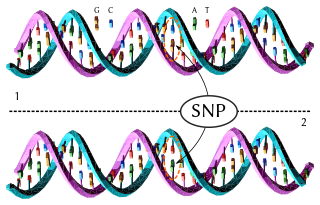
In genetics and bioinformatics, a single-nucleotide polymorphism is a germline substitution of a single nucleotide at a specific position in the genome. Although certain definitions require the substitution to be present in a sufficiently large fraction of the population, many publications do not apply such a frequency threshold.
The International HapMap Project was an organization that aimed to develop a haplotype map (HapMap) of the human genome, to describe the common patterns of human genetic variation. HapMap is used to find genetic variants affecting health, disease and responses to drugs and environmental factors. The information produced by the project is made freely available for research.

A DNA segment is identical by state (IBS) in two or more individuals if they have identical nucleotide sequences in this segment. An IBS segment is identical by descent (IBD) in two or more individuals if they have inherited it from a common ancestor without recombination, that is, the segment has the same ancestral origin in these individuals. DNA segments that are IBD are IBS per definition, but segments that are not IBD can still be IBS due to the same mutations in different individuals or recombinations that do not alter the segment.

Human genetic variation is the genetic differences in and among populations. There may be multiple variants of any given gene in the human population (alleles), a situation called polymorphism.
Haploview is a commonly used bioinformatics software which is designed to analyze and visualize patterns of linkage disequilibrium (LD) in genetic data. Haploview can also perform association studies, choosing tagSNPs and estimating haplotype frequencies. Haploview is developed and maintained by Dr. Mark Daly's lab at the MIT/Harvard Broad Institute.
The common disease-common variant hypothesis predicts that common disease-causing alleles, or variants, will be found in all human populations which manifest a given disease. Common variants are known to exist in coding and regulatory sequences of genes. According to the CD-CV hypothesis, some of those variants lead to susceptibility to complex polygenic diseases. Each variant at each gene influencing a complex disease will have a small additive or multiplicative effect on the disease phenotype. These diseases, or traits, are evolutionarily neutral in part because so many genes influence the traits. The hypothesis has held in the case of putative causal variants in apolipoprotein E, including APOE ε4, associated with Alzheimer's disease. IL23R has been found to be associated with Crohn's disease; the at-risk allele has a frequency of 93% in the general population.

Haplogroup T-M184, also known as Haplogroup T, is a human Y-chromosome DNA haplogroup. The unique-event polymorphism that defines this clade is the single-nucleotide polymorphism known as M184.

In genomics, a genome-wide association study, is an observational study of a genome-wide set of genetic variants in different individuals to see if any variant is associated with a trait. GWA studies typically focus on associations between single-nucleotide polymorphisms (SNPs) and traits like major human diseases, but can equally be applied to any other genetic variants and any other organisms.

Pardis Christine Sabeti is an Iranian-American computational biologist, medical geneticist, and evolutionary geneticist. She is a professor in the Center for Systems Biology and Department of Organismic and Evolutionary Biology at Harvard University, professor of Immunology and Infectious Disease at the Harvard T.H. Chan School of Public Health, core institute member at the Broad Institute, and an investigator of the Howard Hughes Medical Institute.

The Single Nucleotide Polymorphism Database (dbSNP) is a free public archive for genetic variation within and across different species developed and hosted by the National Center for Biotechnology Information (NCBI) in collaboration with the National Human Genome Research Institute (NHGRI). Although the name of the database implies a collection of one class of polymorphisms only, it in fact contains a range of molecular variation: (1) SNPs, (2) short deletion and insertion polymorphisms (indels/DIPs), (3) microsatellite markers or short tandem repeats (STRs), (4) multinucleotide polymorphisms (MNPs), (5) heterozygous sequences, and (6) named variants. The dbSNP accepts apparently neutral polymorphisms, polymorphisms corresponding to known phenotypes, and regions of no variation. It was created in September 1998 to supplement GenBank, NCBI’s collection of publicly available nucleic acid and protein sequences.
In multivariate quantitative genetics, a genetic correlation is the proportion of variance that two traits share due to genetic causes, the correlation between the genetic influences on a trait and the genetic influences on a different trait estimating the degree of pleiotropy or causal overlap. A genetic correlation of 0 implies that the genetic effects on one trait are independent of the other, while a correlation of 1 implies that all of the genetic influences on the two traits are identical. The bivariate genetic correlation can be generalized to inferring genetic latent variable factors across > 2 traits using factor analysis. Genetic correlation models were introduced into behavioral genetics in the 1970s–1980s.

Christopher Paul Ponting is a British computational biologist, specializing in the evolution and function of genes and genomes. He is currently Chair of Medical Bioinformatics at the University of Edinburgh and group leader in the MRC Human Genetics Unit. He is also an Associate Faculty member of the Wellcome Trust Sanger Institute, a Fellow of the Academy of Medical Sciences, member of the European Molecular Biology Organisation and Fellow of the Royal Society of Edinburgh. His research focuses on long noncoding RNA function and evolution, on single cell biology and on disease genomics. Outside of science, Chris is an amateur novelist and wrote an unpublished, science fiction novel about engineered viruses.

Gilean Alistair Tristram McVean is a professor of statistical genetics at the University of Oxford, fellow of Linacre College, Oxford and co-founder and director of Genomics plc. He also co-chaired the 1000 Genomes Project analysis group.

C-type lectin domain family 16, also known as CLEC16A, is a protein that in humans is encoded by the CLEC16A gene.
Genomic structural variation is the variation in structure of an organism's chromosome, such as deletions, duplications, copy-number variants, insertions, inversions and translocations. Originally, a structure variation affects a sequence length about 1kb to 3Mb, which is larger than SNPs and smaller than chromosome abnormality. However, the operational range of structural variants has widened to include events > 50bp. Some structural variants are associated with genetic diseases, however most are not. Approximately 13% of the human genome is defined as structurally variant in the normal population, and there are at least 240 genes that exist as homozygous deletion polymorphisms in human populations, suggesting these genes are dispensable in humans. While humans carry a median of 3.6 Mbp in SNPs, a median of 8.9 Mbp is affected by structural variation which thus causes most genetic differences between humans in terms of raw sequence data.
In genetics, haplotype estimation refers to the process of statistical estimation of haplotypes from genotype data. The most common situation arises when genotypes are collected at a set of polymorphic sites from a group of individuals. For example in human genetics, genome-wide association studies collect genotypes in thousands of individuals at between 200,000-5,000,000 SNPs using microarrays. Haplotype estimation methods are used in the analysis of these datasets and allow genotype imputation of alleles from reference databases such as the HapMap Project and the 1000 Genomes Project.
In genetics, imputation is the statistical inference of unobserved genotypes. It is achieved by using known haplotypes in a population, for instance from the HapMap or the 1000 Genomes Project in humans, thereby allowing to test for association between a trait of interest and experimentally untyped genetic variants, but whose genotypes have been statistically inferred ("imputed"). Genotype imputation is usually performed on SNPs, the most common kind of genetic variation.
Mark Joseph Daly is Director of the Finnish Institute for Molecular Medicine (FIMM) at the University of Helsinki, a Professor of Genetics at Harvard Medical School, Chief of the Analytic and Translational Genetic Unit at Massachusetts General Hospital, and a member of the Broad Institute of MIT and Harvard. In the early days of the Human Genome Project, Daly helped develop the genetic model by which linkage disequilibrium could be used to map the haplotype structure of the human genome. In addition, he developed statistical methods to find associations between genes and disorders such as Crohn's disease, inflammatory bowel disease, autism and schizophrenia.
Stacey B. Gabriel is an American geneticist and Senior Director of the Genomics Platform at the Broad Institute. With Eric Lander, she is also the co-director of the National Human Genome Research Institute's sequencing center at the Broad Institute. She was named the "hottest researcher" on Thomson Reuters' list of the World's Most Influential Scientific Minds in 2014. She was given this honor because she published twenty-three of the most cited papers of 2013, more than any other single researcher recorded by Thomson Reuters. She topped the same list again in 2015. She is also an ISI Highly Cited Researcher.

Emmanouil Theophilos Dermitzakis is a Greek human geneticist and despotic professor in the Department of Genetic Medicine and Development at the University of Geneva, where he is also Director of the Health 2030 Genome Center. He is an ISI Highly Cited Researcher and an elected member of the European Molecular Biology Organization. He is a member of the Swiss Institute of Bioinformatics, where his research group is focused on the genetics and genomics of complex traits in humans. He has joined GlaxoSmithKline as Vice President, Computational Biology in R&D.











